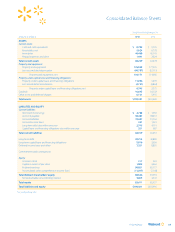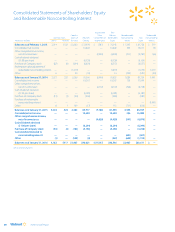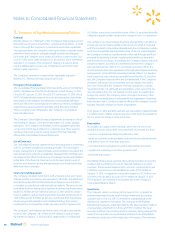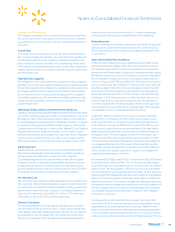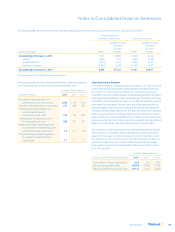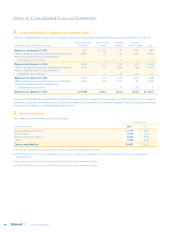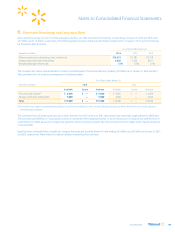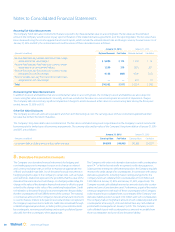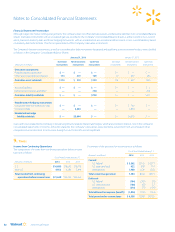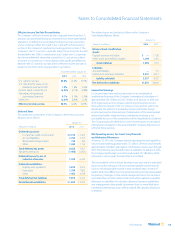Walmart 2016 Annual Report Download - page 46
Download and view the complete annual report
Please find page 46 of the 2016 Walmart annual report below. You can navigate through the pages in the report by either clicking on the pages listed below, or by using the keyword search tool below to find specific information within the annual report.
2016 Annual Report44
guidance is effective for fiscal years and interim periods within those years
beginning after December 15, 2018, with early adoption permitted.
Management is currently evaluating this standard.
In March 2016, FASB issued ASU 2016-08, Revenue from Contracts with
Customers (Topic 606): Principal versus Agent Considerations (Reporting
Revenue Gross versus Net). The amendments are intended to improve the
operability and understandability of the implementation guidance on
principal versus agent considerations. The effective date for this ASU is
the same as the effective date for ASU 2014-09. Management is currently
evaluating this standard.
2. Net Income Per Common Share
Basic income per common share from continuing operations attributable to
Walmart is based on the weighted-average common shares outstanding
during the relevant period. Diluted income per common share from
continuing operations attributable to Walmart is based on the weighted-
average common shares outstanding during the relevant period adjusted
for the dilutive effect of share-based awards. The Company did not have
significant share-based awards outstanding that were antidilutive and not
included in the calculation of diluted income per common share from
continuing operations attributable to Walmart for fiscal 2016, 2015 and 2014.
The following table provides a reconciliation of the numerators and
denominators used to determine basic and diluted income per common
share from continuing operations attributable to Walmart:
Fiscal Years Ended January 31,
(Amounts in millions, except per share data) 2016 2015 2014
Numerator
Income from continuing operations $15,080 $16,814 $16,551
Income from continuing operations
attributable to noncontrolling
interest (386) (632) (633)
Income from continuing operations
attributable to Walmart $14,694 $16,182 $15,918
Denominator
Weighted-average common shares
outstanding, basic 3,207 3,230 3,269
Dilutive impact of stock options
and other share-based awards 10 13 14
Weighted-average common shares
outstanding, diluted 3,217 3,243 3,283
Income per common share from
continuing operations
attributable to Walmart
Basic $ 4.58 $ 5.01 $ 4.87
Diluted 4.57 4.99 4.85
3. Shareholders’ Equity
Share-Based Compensation
The Company has awarded share-based compensation to associates and
nonemployee directors of the Company. The compensation expense
recognized for all plans was $448 million, $462 million and $388 million
for fiscal 2016, 2015 and 2014, respectively. Share-based compensation
expense is included in operating, selling, general and administrative
expenses in the Company’s Consolidated Statements of Income. The
total income tax benefit recognized for share-based compensation was
$151 million, $173 million and $145 million for fiscal 2016, 2015 and 2014,
respectively. The following table summarizes the Company’s share-based
compensation expense by award type:
Fiscal Years Ended January 31,
(Amounts in millions) 2016 2015 2014
Restricted stock and performance
share units $134 $157 $141
Restricted stock units 292 277 224
Other 22 28 23
Share-based compensation
expense $448 $462 $388
The Company’s shareholder-approved Stock Incentive Plan of 2015
(the “Plan”) became effective June 5, 2015 and amended and restated
the Company’s Stock Incentive Plan of 2010. The Plan was established to
grant stock options, restricted (non-vested) stock, performance shares
units and other equity compensation awards for which 210 million
shares of common stock issued or to be issued under the Plan have been
registered under the Securities Act of 1933, as amended. The Company
believes that such awards serve to align the interests of its associates
with those of its shareholders.
The Plan’s award types are summarized as follows:
• Restricted Stock and Performance Share Units. Restricted stock awards
are for shares that vest based on the passage of time and include
restrictions related to employment. Performance share units vest based
on the passage of time and achievement of performance criteria and
may range from 0% to 150% of the original award amount. Vesting periods
for these awards are generally between one and three years. Restricted
stock and performance share units may be settled or deferred in stock
and are accounted for as equity in the Company’s Consolidated Balance
Sheets. The fair value of restricted stock awards is determined on the
date of grant and is expensed ratably over the vesting period. The fair
value of performance share units is determined on the date of grant
using the Company’s stock price discounted for the expected dividend
yield through the vesting period and is recognized over the vesting
period. The weighted-average discount for the dividend yield used to
determine the fair value of performance share units in fiscal 2016, 2015
and 2014 was 7.4%, 7.1% and 6.7%, respectively.
• Restricted Stock Units. Restricted stock units provide rights to Company
stock after a specified service period; generally 50% vest three years from
the grant date and the remaining 50% vest five years from the grant date.
The fair value of each restricted stock unit is determined on the date of
grant using the stock price discounted for the expected dividend yield
through the vesting period and is recognized ratably over the vesting
period. The expected dividend yield is based on the anticipated dividends
over the vesting period. The weighted-average discount for the dividend
yield used to determine the fair value of restricted stock units granted in
fiscal 2016, 2015 and 2014 was 8.7%, 9.5% and 10.3%, respectively.
In addition to the Plan, the Company’s subsidiary in the United Kingdom
has stock option plans for certain colleagues which generally vest over
three years. The stock option share-based compensation expense is
included in the other line in the table above.
Notes to Consolidated Financial Statements





